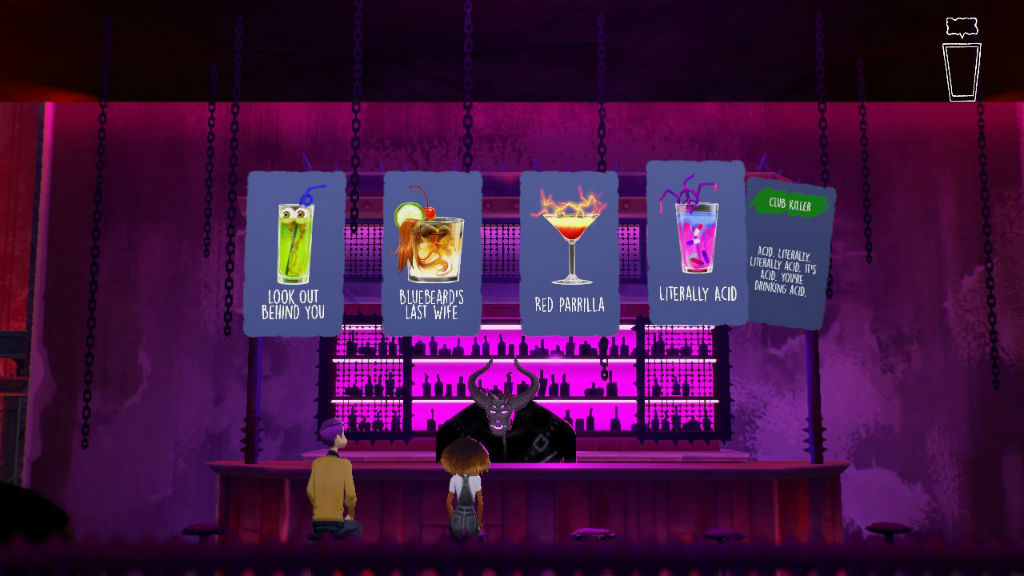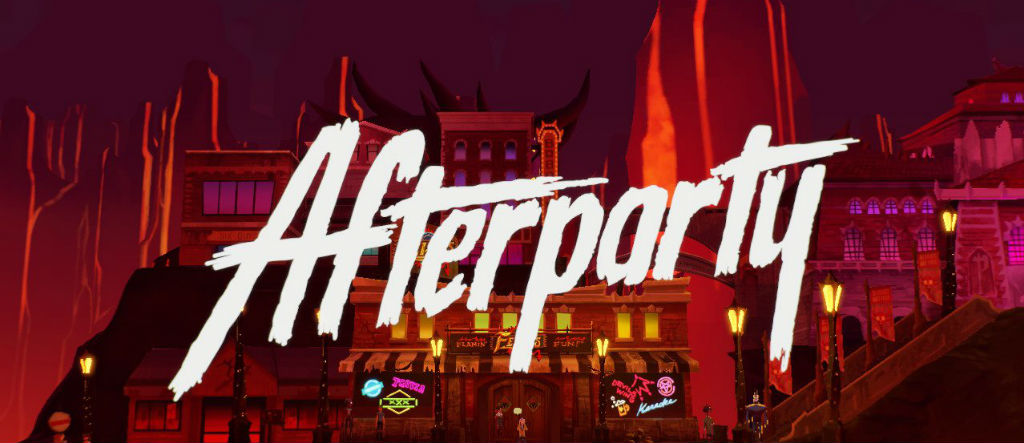The elevator pitch for Night School’s After Party‘s is debauched, at least in theory. Two friends die, go to hell, and then have to out-drink Satan himself in order to escape. In hell, drinks are free, and once the 9-5 grind of torture is over, all anyone wants to do is get hammered.
It’s a concept you might think is open to accusations that the game is glorifying alcohol use, which is probably why it features an extended narrative about how drinking to excess is a fruitless way of avoiding reality. Still, the game’s narrative arc is built on drinking, with additional dialogue options given to main characters, Milo and Lola, if they have a certain drink in hand. In theory, it’s a narrative game with a unique twist, full of comedic potential and a winking take on game design itself. But on the Nintendo Switch version of Afterparty, out this week, the game’s concepts are better in theory than execution.

Visually, Afterparty is a fun and colorful look at a hell where there are bars and nightclubs everywhere. Demons are tortured by humans, then drink together to forget it all and start over the next morning. The world the game builds is clever and funny, and the music is great. But some of the visuals are tough to see on the Switch screen, or even on a TV. The camera stays far from the heroes themselves, limiting our view of the protagonists as little more than vague character features. All of that is fleshed out by a narrative characterization that unfolds with your help, but the zoomed-out nature of everything can be distracting.
The strength of the game is its voice acting, which is excellent throughout. Ashly Burch (Mythic Quest) shines as a witty cab driver shuttling you around the River Styx, while main characters Milo (Khoi Dao) and Lola (Janina Gavankar, The Morning Show) are great here, too. Building a narrative game around that dialogue, though, opens up the potential for gameplay issues. If you don’t pick a dialogue choice in time, or press a button to start dialogue too early, things get cut off and are uneven. You can easily lose options forever if you aren’t sure what to do, with no real way of going back. There’s a lot of hurry up and wait, with the distinct possibility that you will miss a surprisingly narrow window to do one of the few things available to you in the game. Fitting these narrative set pieces together takes work, and that’s really the game part of the game. But there’s not much playing to do, and it’s entirely unclear if playing it wrong has any impact on what’s going on until it’s too late.
What stands out most about the Switch version of Afterparty, unfortunately, is long load times and choppy animations. The game has you ferrying to different islands of hell, with unskippable narrative parts played out on these taxi rides. But the animation was never smooth for these, with skittering imagery, frequent slowdowns and outright pauses that were hard to ignore. I often got trapped, frozen in bars after trying to get out, and some scenes wouldn’t trigger without reloading the game altogether.
I know it’s extremely hard to clean all of these little problems up, especially in an indie title that’s porting from other versions. But it felt particularly egregious here, especially when so much of the game is waiting for dialogue to play out already. All that time makes it easy to notice the flaws, even if the story that you do get is engaging and funny. The talent at play here in voicing the game is likely enough to give Night School your money, but only if you are willing to endure what can be a hellish grind of load times and buggy menus that feels like an unintentional meta criticism of demonic gaming itself. Perhaps the other console versions have fewer problems, as they’ve seen favorable reviews elsewhere, but gameplay itself was a struggle at times, too.
The social media element of the game also feels unnecessary, with chat bubbles occasionally popping up from a Twitter-like demonic app that sometimes relate to the plot but are mostly for comic relief. The point is for it to be funny, but sometimes they are unreadable, or obscure other things you’re actually trying to do that are more essential to gameplay. It feels like an attempt to make Afterparty a more substantial game than it is, but only serves to more clearly show the game’s seams in the process.
If you can live with those flaws, the humor and story are worth the trip and seeing its multiple potential endings, but you might not have much interest in doing it all again once you get out of hell.

